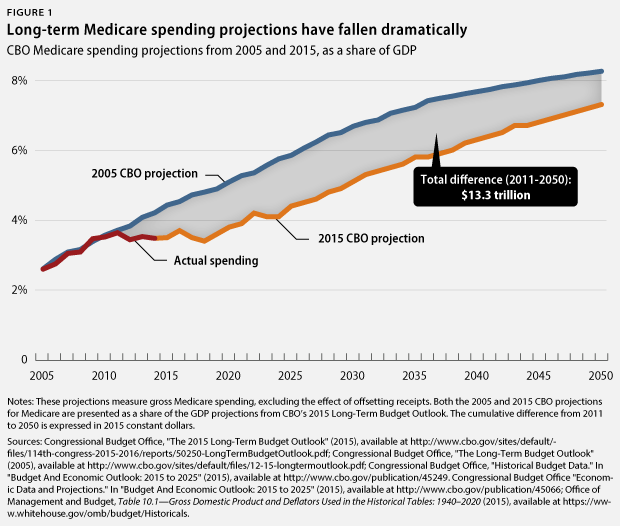New data released yesterday from the nonpartisan Congressional Budget Office, or CBO, show an enormous decline in projected Medicare spending compared with earlier CBO reports. Even though the new Medicare numbers are higher than CBO’s 2014 projection, they still reflect a decade of remarkable progress in controlling Medicare spending.
The declining Medicare projections are not just limited to recent years, when health care costs grew unusually slowly; long-term projections for Medicare spending have also fallen dramatically, even though CBO assumes that the recent slowdown in health care cost growth will not continue indefinitely. Looking ahead to 2050—the final year covered by CBO’s 2005 long-term budget outlook—the difference between CBO’s 2005 and 2015 Medicare spending projections for 2050 is about 0.95 percent of gross domestic product, or GDP, which translates into roughly $370 billion in 2015 constant dollars.* Since 2005, CBO’s projections for total Medicare spending from 2011 to 2050 have fallen by $13.3 trillion.

There are several reasons for the falling Medicare projections, including lower estimates for health care cost growth, lower-than-expected costs for the Medicare Part D prescription drug program, and the Affordable Care Act, or ACA. The ACA included substantial cost-saving Medicare reforms, which were reflected in CBO’s official cost estimate for the bill. The implementation of the ACA may also be one of the factors responsible for the broader decline in health care cost growth; it already appears to be reducing the number of patients who need to be readmitted to hospitals.
The falling Medicare spending projections prove that there is no need to turn Medicare into a voucher program or to make other draconian benefit cuts in order to bring Medicare spending to more sustainable levels. The Center for American Progress has offered several policy options to make Medicare work even more efficiently, including the Senior Protection Plan, Accountable Care States, and improvements to the accountable care organization model. Lawmakers should look to policies such as these to increase Medicare efficiency and improve service for Medicare beneficiaries instead of cutting Medicare in ways that only shift the burden of higher costs onto senior citizens.
Harry Stein is the Director for Fiscal Policy at the Center for American Progress.
* Author’s note: These projections measure gross Medicare spending, excluding the effect of offsetting receipts. Both the 2005 and 2015 CBO projections for Medicare are presented as a share of the GDP projections from CBO’s 2015 long-term budget outlook. This focuses the analysis solely on changes to the Medicare projections and excludes effects that are due to changes in GDP concepts and projections.